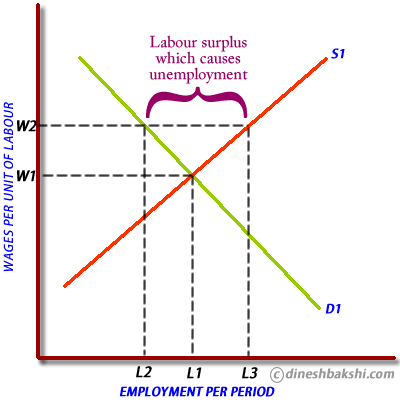Government intervention through minimum wages
A minimum wage is the lowest hourly, daily or monthly wage that employers may legally pay to employees or workers.
The main aim of introducing minimum wages is to reduce poverty and the exploitation of workers who have little or no bargaining power with their employers.
If a higher minimum wage increases the wage rates of unskilled workers above the level that would be established by market forces, the quantity of unskilled workers employed will fall. The minimum wage will price the services of the least productive (and therefore lowest-wage) workers out of the market. ... The direct results of minimum wage legislation are clearly mixed. Some workers, most likely those whose previous wages were closest to the minimum, will enjoy higher wages. Other, particularly those with the lowest prelegislation wage rates, will be unable to find work. They will be pushed into the ranks of the unemployed or out of the labor force.

Suppose the current equilibrium wage of unskilled workers is W1, determined by the intersection of the demand and supply curves of these workers. The government determines that this wage is too low and orders that it be increased to Wm, a minimum wage. This strategy reduces employment from L1 to L2, but it raises the incomes of those who continue to work. The higher wage also increases the quantity of labour supplied to L3. The gap between the quantity of labour supplied and the quantity demanded, L3 ? L2, is a surplus—a surplus that increases unemployment.
An alternative approach to imposing a legal minimum is to try to boost the demand for labor. Such an approach is illustrated in the graph below. An increase in demand to D2 pushes the wage to W2 and at the same time increases employment to L2. Public sector training programs that seek to increase human capital are examples of this policy.






